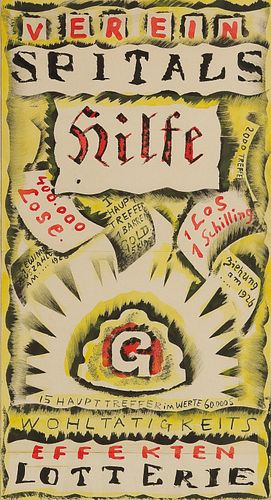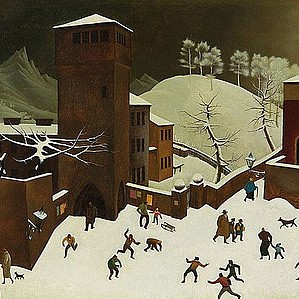FRANZ VON ZÜLOW (Vienna 1883 - 1963 Vienna) Design for a Lottery Poster, 1926
Lot 100
Categories
Estimate:
EUR€1,000 - EUR€2,000
$1,063.83 - $2,127.66
Absentee vs Live bid
Two ways to bid:
- Leave a max absentee bid and the platform will bid on your behalf up to your maximum bid during the live auction.
- Bid live during the auction and your bids will be submitted real-time to the auctioneer.
Bid Increments
| Price | Bid Increment |
|---|---|
| EUR€0 | EUR€10 |
| EUR€100 | EUR€50 |
| EUR€700 | EUR€100 |
| EUR€1,000 | EUR€200 |
| EUR€3,000 | EUR€300 |
| EUR€3,600 | EUR€400 |
| EUR€4,000 | EUR€500 |
| EUR€7,000 | EUR€1,000 |
| EUR€16,000 | EUR€2,000 |
| EUR€30,000 | EUR€3,000 |
| EUR€36,000 | EUR€4,000 |
| EUR€40,000 | EUR€5,000 |
About Auction
By Widder Auctions
May 19, 2022
Set Reminder
2022-05-19 11:00:00
2022-05-19 11:00:00
America/New_York
Bidsquare
Bidsquare : Masterpieces
https://www.bidsquare.com/auctions/widder-auctions/masterpieces-9287
Masterpieces of classical modernism by Austrian and international artists coming up for auction in Vienna on May 19th Widder Auctions office@widderauktionen.com
Masterpieces of classical modernism by Austrian and international artists coming up for auction in Vienna on May 19th Widder Auctions office@widderauktionen.com
- Lot Description
FRANZ VON ZÜLOW*
(Vienna 1883 - 1963 Vienna)
Design for a Lottery Poster, 1926
watercolor and indian ink/paper, 58 x 33 cm
Provenance: collection Gusel Austria, private property Vienna
ESTIMATE °€ 1.000 - 2.000
Austrian painter and graphic artist of the 20th century. Representative of the Classical Modernism. Studied at the Vienna School of Applied Arts from 1903 to 1906 under Felician Myrbach and Carl Otto Czeschka. Explored graphic techniques, developed his own paper-cutting stencil technique in 1907. Participates in the 1908 art show organized by Gustav Klimt and Josef Hoffmann. Commissioned by Josef Hofmann to design wallpaper for a children's room in the Palais Stoclet. From 1909 in Haugsdorf, where his mother and sister lived. 1915 to 1919 military service, became an Italian prisoner of war. 1920 to 1922 teacher at the Schleiß ceramic workshops in Gmunden. From 1922 he commuted between Vienna and Upper Austria. Arts and crafts works and illustrations for the Wiener Werkstätte, among others. From the 1920s also oil paintings, especially landscapes. Belonged to the Zinkenbach painters' colony in the interwar period, like Ferdinand Kitt, Josef Dobrowsky, Ernst Huber, Ludwig Heinrich Jungnickel, Oskar Laske, Georg Merkel, Louise Merkel-Romee and Georg Ehrlich. 1942 Prohibited from painting. 1945 Member of the Vienna Secession and the Linz Artists' Association MAERZ. From 1949 teacher at the School of Arts and Crafts in Linz and from 1955 president of the Mühlviertler Künstlergilde. Influenced by the decorative and flat ornamental art of Jugendstil and folk art. Created mainly children's books, posters, calendar graphics, murals, wallpaper, carpets, fabrics. But also prints, watercolors, drawing and oil paintings with landscapes, rural and religious motifs, fairy-tale and fantastic scenes.
Franz Zülow attended the Graphic Teaching and Research Institute in 1901 and 1902 and also enrolled briefly at the Academy of Fine Arts before studying at the Vienna School of Applied Arts from 1903 to 1906. From an early age, Zülow experimented intensively with graphic techniques and in 1907 developed, among other things, the paper cutting stencil technique, which he also patented. From 1908 on, he was a member of the Klimt Group. In 1909 he moved to Haugsdorf, where his mother and sister lived. In 1912, a scholarship enabled him to undertake an extensive study trip through Western Europe. From 1915 to 1919 he did military service and was taken prisoner by the Italians. Between 1920 and 1922 he worked as a teacher at the Schleiss ceramic workshops in Gmunden. From 1922 he lived alternately in Vienna and Upper Austria and undertook several trips abroad. His decorative arts and illustrative works, which were often created for the Wiener Werkstätte, were characterized by the decorative verve of the Secession. From the 1920s he created the first oil paintings, which, like his paste-the-wall paintings and watercolors, mainly show landscapes. In the years between 1928 and 1935 he was awarded the Austrian State Prize several times, and in 1942 he was forbidden to paint by the Nazi regime. From 1933 to 1939 and from 1945 on, he belonged to the Vienna Secession and was also a member of the Linz Artists' Association Maerz. From 1949 he taught at the School of Applied Arts in Linz and from 1955 he was President of the Mühlviertler Artists' Guild. During this period he received numerous public commissions for murals and mosaics. The sheet “Verein Spitalshilfe Charity Effects Lottery” from 1926 belongs in the category of occasional graphics, in which, according to the registered inserts, 400,000 tickets were issued and “15 main hits worth (of) 60,000 Schilling” as well as a five-kilo gold bar are promised as the main hit. Both the presentation and the promise of prizes unmask the sheet as a “cheerful finger exercise” by the artist.
PLEASE NOTE:
The purchase price consists of the highest bid plus the buyer's premium, sales tax and, if applicable, the fee of artists resale rights. In the case of normal taxation (marked ° in the catalog), a premium of 24% is added to the highest bid. The mandatory sales tax of 13% is added to the sum of the highest bid and the buyer's premium. The buyer's premium amounts to 28% in case of differential taxation. The sales tax is included in the differential taxation. - Shipping Info
-
Shipping
We will send you the invoice shortly after the auction. As soon as we have recieved the amount, the art can be picked up at Johannesgasse 9-13, 1010 Vienna. Please note that the buyer is responsible for pick-up and shipping of the lot.
Should you wish to ship your items, please contact: Mailboxes Email: oper@mbe-co.at Tel: 01 5128855
Please note that storage fees may apply, should the pieces not be picked up within 14 days after invoicing for domestic and 28 days for international transportation.
Our team will be happy to assist you with any further information at office@widderauktionen.com or at 0043 676 555 66 10.
-
- Buyer's Premium



 EUR
EUR CAD
CAD AUD
AUD GBP
GBP MXN
MXN HKD
HKD CNY
CNY MYR
MYR SEK
SEK SGD
SGD CHF
CHF THB
THB













